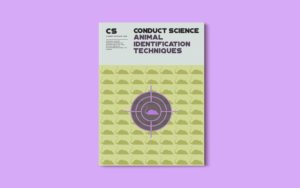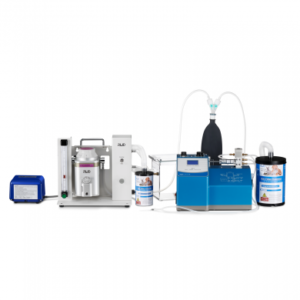Introduction
Ion Exchange Chromatography (IEC) is a powerful liquid chromatographic technique used for bioseparation. The separation is done by a reversible interaction between charged molecules of the sample with charged ligands attached to a column. The method offers a sizeable sample-handling capacity, powerful resolving ability, broad applicability, moderate cost, and ease of handling. These characteristics have made ion-exchange chromatography one of the most versatile and widely used liquid chromatography techniques. Ion exchange chromatography is frequently used for the separation and purification of polypeptides, proteins, enzymes, antibodies, nucleic acids, polynucleotides, and other charged biomolecules.
There are two types of ion-exchange chromatography: anion-exchange and cation-exchange. Cation-exchange chromatography is used for the positively charged molecules. In this type of chromatography, the stationary phase is negatively charged, which attracts the positively charged molecules of interest. Whereas, in anion-exchange chromatography, the stationary phase is positively charged which attracts the negatively charged molecules. It is prominently used in protein purification, water analysis, and quality control. The bound molecules are eluted and collected using an eluant containing anions and cations by running a higher concentration of ions through the column or changing the pH of the column.
Principle
Ion-exchange chromatography separates the molecules based on their respective charged groups. The ion-exchange chromatography consists of both mobile and stationary phases, the former is usually an aqueous buffer system into which the sample of interest is introduced, and the latter is an inert organic matrix chemically derived with ionizable functional groups carrying an oppositely charged counterion. The molecules undergo electrostatic interactions with opposite charges present on the stationary phase matrix. For electroneutrality, these inert charges interact with exchangeable counterions in the solution. Ionizable molecules that are to be resolved to compete with these counterions for binding to the displaceable charges on the stationary phase. These molecules are retained or eluted according to their respective charges.
Apparatus & Equipment
The ion-exchange chromatography consists of a series of mobile phase reservoirs containing a range of different mobile phases. The reservoirs are made of glass or plastic because the mobile phases can have extreme pH values. The components of the ion-chromatography system include pumps, conduits, valves, sampling devices, columns, and detector cells. The solvent reservoirs are attached with a solvent selection valve and a solvent programmer. The solvent then passes from the selector to a high-pressure pump. The mobile phase passes to the sampling device from the pump and relays onto the column. The exit flow from the column passes the solvent to the detector. The detector could be an electrical conductivity detector or the UV detector. The output from the detector sensor is electronically modified and presents the ion concentration on the computer.
Protocol
- Prepare the protein mixture by adding 0.2ml [amazon link=”B014V89HD2″ link_icon=”amazon” /]to the protein extract vial. Vortex the mixture until completely dissolved.
- Centrifuge the tube for 2 minutes in a microcentrifuge at maximum speed to remove the foam.
- Clamp the chromatography column on the stand in an upright position.
- Open the caps of the column (top cap first).
- Drain the buffer through the column, under gravity, in a waste container.
- Ensure that the column resin settles down in the column.
- Add 1ml equilibration buffer, allow it to drain out, and then drain the second 1 ml.
- Carefully load the protein extract from step 2 to the column.
- Wash the column with equilibration buffer four times to remove the unbound protein. Collect 2ml wash fractions as the buffer drains into labeled 2ml collection tubes.
- Elute the sample with a salt gradient: equilibration buffer, elution buffer, and a high salt buffer.
- Apply 1ml of the gradient elution buffer to the column.
- Collect 1ml fractions as the buffer drains into the collection tubes. Collect all elutions in separate 2ml tubes.
- Note the color changes of the fractions.
- Determine the protein concentration of the fractions.
Calculating the protein concentration
- Label the tubes and transfer 50μl elute from each fraction to 10 tubes.
- Gently mix the RED660 reagent by inverting the bottle several times.
- Add 1ml RED660 reagent to the tube and vortex.
- Incubate the tubes for 5 minutes at room temperature.
- Turn ON the spectrophotometer and adjust the wavelength.
- Add 1ml distilled water or the 660 reagents to a cuvette to make the absorbance zero. Record the absorbance value for each tube.
Sample preparation
- Perform desalting of the protein sample.
Resin equilibration
- Wash the 100-200 g resin with water and remove the fines by stirring and aspirating the supernatant.
- Wash the defined resin with 500 mL [amazon link=”B07328TQW5″ link_icon=”amazon” /] (200 mM) to achieve equilibration. Gently stir the resin into a slurry, and transfer it to a sintered glass column containing a small volume of water. Pass 10 mM Tris-HCl through the column until it is completely equilibrated.
Chromatography
- Apply the sample to the equilibrated resin, and collect the effluent.
- Apply a gradient (2 x 500 mL) of 0-100 mM [amazon link=”B00J5YHGEA” link_icon=”amazon” /] in 10 mM [amazon link=”B07328TQW5″ link_icon=”amazon” /] to elute the bound protein.
- Collect the fractions in a fraction collector, and record the protein concentration, and conductivity.
Preparation of bovine cytosolic extract
- Thoroughly homogenize 50 g whole brain slice in 200 mL of ice-cold Buffer A (100 mM [amazon link=”B00WSDILWQ” link_icon=”amazon” /] pH 7.4, 5 mM DTT ([amazon link=”B076MLXQPP” link_icon=”amazon” /]) and 0.5 mM [amazon link=”B00I31P7WY” link_icon=”amazon” /]).
- Centrifuge the homogenate for 45 minutes at 36,000 × g to get a supernatant (S1) and pellet (P1).
- Resuspend the pellet in 100 mL of ice-cold distilled water and recentrifuge to get second supernatant (S2) and pellet (P2). Discard this pellet.
- Combine S1 and S2 fractions and ultracentrifuge for 45 minutes at 100,000 × g to get a whole brain supernatant (S3) for storage as 40 mL aliquots at -20 °C/-80 °C. Discard the P3 pellet.
Ammonium sulfate precipitation
- Add [amazon link=”B000OV85BQ” link_icon=”amazon” /] to 40 mL of S3 and stir it constantly to give 45 % (w/v) saturation and adjust the pH to 7.4 by adding 1 M [amazon link=”B00ILIDWU8″ link_icon=”amazon” /].
- Remove the precipitated contaminants by centrifugation (refrigerated) for 45 minutes at 36,000 × g. Retain the supernatant (S4) and discard the pellet (P4).
- Add solid ammonium sulfate to S4 and stir to give 75 % saturation (9.39 g at 4 °C) and adjust the pH to 7.4 by adding 1 M NaOH.
- Repeat step 2 and retain the pellet (P5). Resuspend it in 5 mL of Buffer B: 50 mM [amazon link=”B07328TQW5″ link_icon=”amazon” /] pH 8.0, 5 mM [amazon link=”B076MLXQPP” link_icon=”amazon” /] and 0.5 mM [amazon link=”B00I31P7WY” link_icon=”amazon” /] to get a “post-ammonium sulfate extract.”
- Dialyze the post-ammonium sulfate extract for 12 hours against Buffer B.
Partial purification of Prolyl Oligopeptidase
- Equilibrate a 20 mL DEAE-Sepharose column with 100 mL of Buffer B.
- Apply the dialyzed post-ammonium sulfate extract to the column and wash the unbound contaminants using 100 mL of Buffer B.
- Elute bound propyl oligopeptidase using a 100 mL linear NaCl gradient prepared in Buffer B.
- Regenerate the DEAE column with 60 mL of 350 mM NaCl in Buffer B, followed by 100 mL of NaCl-free Buffer B.
- Assay eluted fractions for total protein and POP activity.
Post-DEAE fractions assay
- Make the substrate stock (10 mM Z -Gly-Pro-MCA) in 100 % [amazon link=”B001L538IY” link_icon=”amazon” /]. Add 600 mL DMSO in 200 mL of substrate stock, followed by Buffer A to make a final volume of 10 mL.
- Add 400 mL of 200 mM substrate to 100 mL of post-DEAE fraction and incubate it at 37 °C for 30 minutes.
- Terminate the assay reactions after 30 minutes by adding 1 mL of 1.5 M [amazon link=”B078C959XB” link_icon=”amazon” /].
- Prepare a negative control by adding 1 mL of 1.5 M acetic acid to a 100 mL aliquot of Fraction 1 “prior” to the addition of substrate.
- Monitor liberated MCA by fluorescence spectrophotometry at excitation and emission wavelengths of 370 and 440 nm, respectively.
Applications
Analysis of the components of a Clostridium difficile vaccine (Rustandi. et al., 2016)
The ion-exchange chromatography was used to characterize the charged variant heterogeneities and to monitor the stability of antigenic components of the Clostridium difficile vaccine. In the study, a novel tetravalent C. difficile vaccine containing all four toxins was developed from an insect cell expression system. Clostridium difficile is the leading pathogen causing nosocomial diarrhea. The main virulence factors are two large glucosyltransferase proteins, toxin A (TcdA) and toxin B (TcdB). These factors are considered to be the primary factors responsible for the symptoms of the infection. The ion-exchange chromatography is a powerful separation technique for the characterization and analysis of protein antigenic components.
Determination of the protein concentration (Hugli. & Moore., 1972)
The ion-exchange chromatography was used for quantitative recoveries of tryptophan on an automatic analyzer. The proteins were hydrolyzed at 110o or 135o in NaOH containing 25 mg of starch. In the study, n-tryptophan was chromatographed on PA-35 resin and yielded values for carbon, hydrogen, and nitrogen within 1.0% of the calculated values. Integral values were obtained for the tryptophan residues in tryptophyl-leucine, porcine pepsin, human serum albumin, sperm whale apomyoglobin, trypsin, bovine a-chymotrypsin, deoxyribonuclease, and serum albumin. The method is advantageous for the measurement of tryptophan in the same hydrolysate used for the determination of the other amino acids. The ion-exchange chromatography could be efficiently used for the determination of amino acid content in hydrolysates.
Characterization of biopharmaceuticals (Fekete., Beck., Veuthey., & Guillarme., 2015)
Ion-exchange chromatography is widely used for the detailed characterization of therapeutic compounds and their derivatives. It can be considered for the qualitative and quantitative assessment of charge heterogeneity of the pharmaceutical agents. The technique has been used for the evaluation of monoclonal antibodies (Mabs), antibody drug conjugates (ADCs), polypeptides, proteins, nucleotides, and nucleic acid conjugates. The ion-exchange chromatography has been employed to separate a wide array of therapeutic agents including C-terminal lysine variants/truncation, deamidated forms, glycoforms, and sialic acid variants. In addition, it also isolates the products of the PEGylation reaction based on the degree of conjugation and the isomeric forms of PEGylated proteins. The method is a promising separation and characterization tool for the analysis of biotherapeutics.
Precautions
- Carefully handle the samples to eliminate contamination for high sensitivity analysis.
- The column used to separate ions has a packing material modified with ion-exchange groups as a stationary phase. Therefore, it has higher hydrophilicity, which can accumulate hydrophobic components from the sample, which can lead to undesirable effects.
- Carefully handle the column as hitting the column or exposure to sudden pressure changes or high pressures could lead to deterioration.
- Avoid precipitation in the column.
- Tris-buffers are temperature sensitive, so they should be adjusted to pH 7.8 at room temperature.
- Keep the sample cold while adding ammonium sulfate.
Strengths and Limitations
- The ion-exchange chromatography is a valuable separation technique for the characterization and detailed analysis of amino acids and proteins.
- The technique can be successfully applied for the evaluation of potential drug candidates and antibody conjugates.
- The method offers a large sample-handling capacity, moderate cost, powerful resolving ability, broad applicability, and ease of handling.
- The ion-exchange chromatography is environment-friendly, can provide a high flow rate, and has a low maintenance cost.
- The method provides high selectivity but relatively poor kinetic performance in bioseparations.
- The presence of a high concentration of non-volatile salts prevents the precise identification of charge variants.
References
- D Sheehan., & FitzGerald., R. (1996). Ion-exchange chromatography. Methods Mol Biol, 59, 145-150.
- T. Hugli., & Moore., S. (1972). Determination of the tryptophan content of proteins by ion exchange chromatography of alkaline hydrolysates. J Biol Chem, 247(9), 2828-34.
- P. Cummins., D. K. Rochfort., & Connor., O. (2017). Ion-Exchange Chromatography: Basic Principles and Application. Methods Mol Biol, 1485, 209-223.
- R. Rustandi., F. Wang., C. Lancaster., A. Kristopeit., S. D. Thiriot., & Heinrichs., H. J. (2016). Ion-Exchange Chromatography to Analyze Components of a Clostridium difficile Vaccine. Methods Mol Biol, 1476, 269-277.
- Fekete., A. Beck., L. J. Veuthey., & Guillarme., D. (2015). Ion-exchange chromatography for the characterization of biopharmaceuticals. J Pharm Biomed Anal, 113, 43-55.












